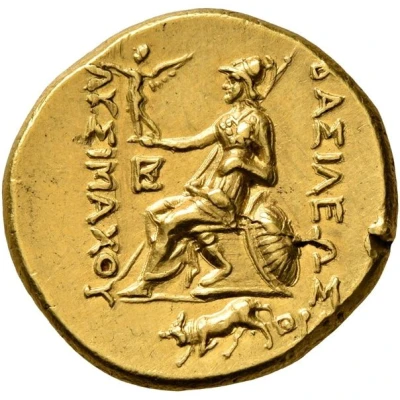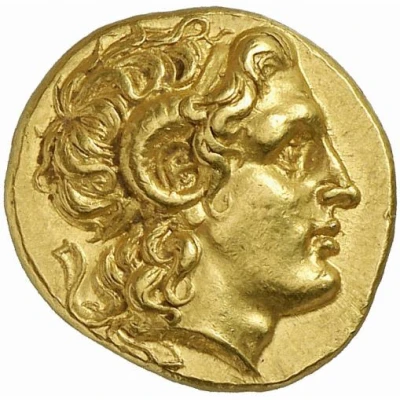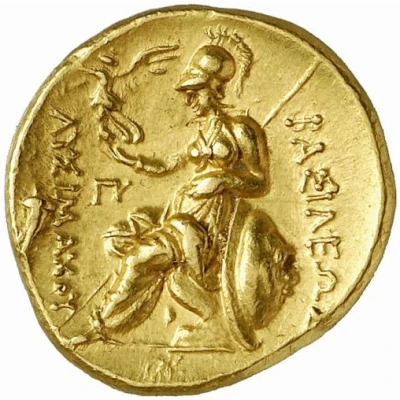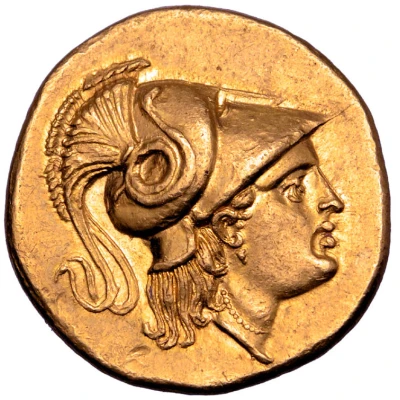
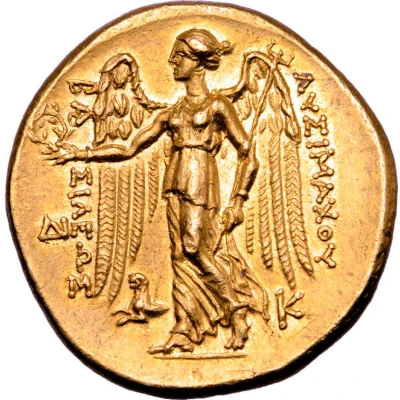

© Roma Numismatics Limited
Stater - Lysimachos Kolophon 299 BC - 296 BC
| Gold | 8.52 g | 21 mm |
| Issuer | Kings of Thrace |
|---|---|
| King | Lysimachus (304 BC - 281 BC) |
| Type | Standard circulation coin |
| Years | 299 BC - 296 BC |
| Value | Gold Stater (20) |
| Currency | Drachm |
| Composition | Gold |
| Weight | 8.52 g |
| Diameter | 21 mm |
| Shape | Round (irregular) |
| Technique | Hammered |
| Demonetized | Yes |
| Updated | 2024-10-10 |
| Numista | N#199796 |
|---|---|
| Rarity index | 100% |
Reverse
Nike standing to left, holding wreath and stylis, ΛΥΣΙΜΑΧΟΥ to left, ΒΑΣΙΛΕΩΣ to right; ΔΙ to outer left, forepart of lion below left wing, K below right wing.
Script: Greek
Lettering:
ΒΑΣΙΛΕΩΣ
ΛΥΣΙΜΑΧΟΥ
ΔΙ
K
Comment
The gold staters in the name of Lysimachos but using the types of Alexander are excessively rare. Exceedingly few examples are known, all struck at the mints of Sestos, Lampsakos, Kolophon, Magnesia and Sardes. This issue of staters was apparently only struck for approximately two years, before being replaced with the more familiar type bearing the head of the deified Alexander on the obverse, and Athena seated on the reverse. Only two other staters from this issue struck at Kolophon bearing these control symbols are known to have survived, along with one other stater with different symbolsThe coin in the main image (8.52g, 21mm, 1h, Near Mint State):
◦ Auctioned by Roma Numismatics Ltd, Auction XVII, 28 March 2019, Lot 425. Sold for 12,000 GBP.
◦ Auctioned by Chaponnière & Firmenich SA, Auction 8, 5 July 2017, lot 16;
◦ Auctioned by CNG - Freeman & Sear - NAC, Triton IV, 5 December 2000, lot 193;
◦ Auctioned by Dr. Busso Peus Nachfolger, Auction 348, 2 May 1996, lot 132;
◦ Auctioned by Dr. Busso Peus Nachfolger, Auction 343, 26 April 1995, lot 115;
◦ Auctioned by Giessener Münzhandlung GmbH, Auction 60, 5 October 1992, lot 95.
Interesting fact
The Lysimachos (Kolophon) Stater coin was minted during the reign of Lysimachos, who was one of the generals of Alexander the Great and later became the ruler of Thrace. The coin features an image of Lysimachos on one side and a lion on the other, which symbolizes his power and authority as a ruler.

